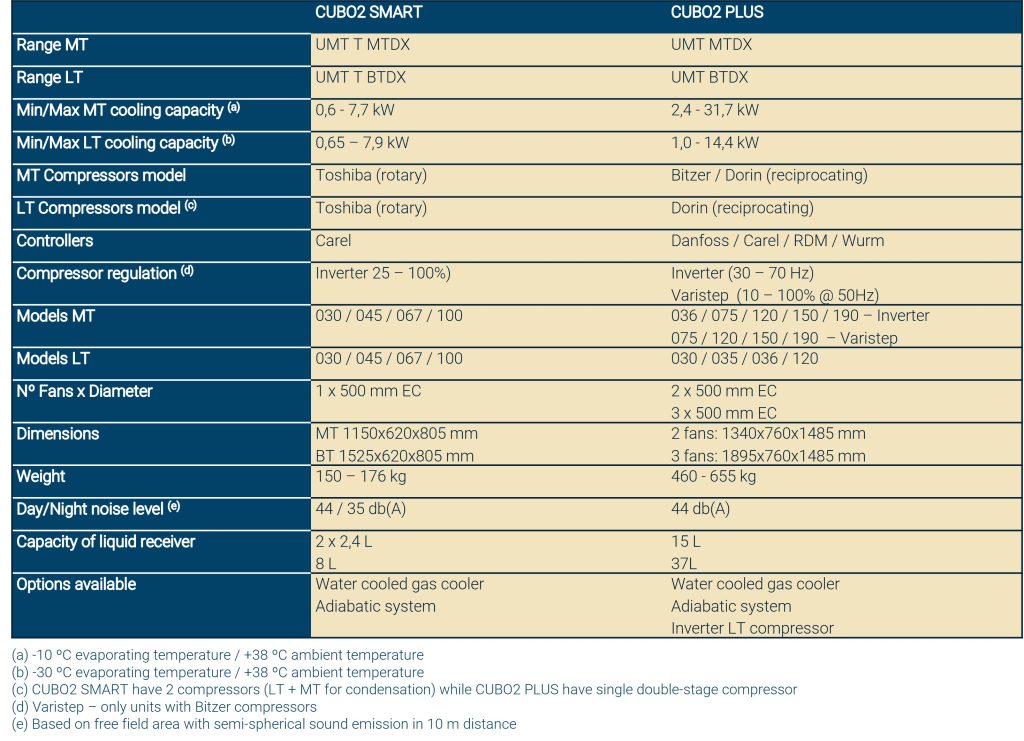Autonomous vs centralized: Finding the Right CO2 Refrigeration system
Does the ideal refrigeration solution exist? What makes a CO2 refrigeration system the perfect fit? It’s all about flexibility and adaptation. Whether in terms of space, scale, or functionality. Companies are looking more and more for solutions that answer their specific needs.
From shops, facilities, and restaurants to warehouses, the list is endless. They are seeking immediate solutions or to complement their existing systems. So, a question appears: should businesses invest in autonomous or centralized refrigeration systems? What is the difference?
It is indeed a path with different requirements and important decisions. Each solution offers its benefits: from energy efficiency and cost to installation complexity and scalability.
Today, we’ll guide you toward the refrigeration solution that best suits your needs. With the help of CO2.
First, why CO2 makes a difference?
CO2 is the refrigerant of choice for businesses committed to sustainability. It’s known for its low global warming potential (GWP) and non-ozone-depleting characteristics. Between efficiency, less energy consumption, and lower operational costs in the long term. Several advantages make CO2 systems a preferred option. Transitioning to a CO2 refrigeration system is happening. Take a step back and learn this process.
Dive into Centralized CO2 Refrigeration Systems
Centralized refrigeration is a perfect fit for large-scale operations. So, if space is not a constraint, that’s a good signal. This product offers a single solution that ensures temperature control throughout large areas. Imagine a single unit with all the power within. This simplifies monitoring and control.
Now join the magic of CO2 as the refrigerant. These systems will guarantee high environmental standards and operational efficiency. The central unit cools CO2 to a liquid state that then circulates through various touchpoints. There, CO2 absorbs heat before returning to the central unit for re-cooling.
What are the advantages of going central? Its efficiency at scale is the main benefit. Using these solutions saves money in the long run because there’s only one system to service. This also makes maintenance easier and less expensive. The ability to control and monitor the system from a central point allows better performance and lower energy consumption.
However, while there are benefits, there are also potential challenges. The initial setup and installation can be costly and complex. The risk of a complete shutdown is higher in the event of a failure. Remember, the refrigeration operation depends on a single system. This can be critical for businesses that need constant refrigeration.
Finally, centralized systems may not be as flexible regarding expansion or reconfiguration compared to autonomous systems.
To summarize, a centralized CO2 refrigeration system is best suited for larger facilities with consistent cooling needs across multiple areas. For example, manufacturing plants, supermarkets, and distribution centres.
Dive into Autonomous CO2 Refrigeration Systems
Autonomous or decentralized refrigeration systems are units that operate independently. Yes, you’re thinking right: it’s a modular approach to cooling. Facilities can use smaller cooling units placed in specific areas. This design allows for flexibility and scalability. Businesses can easily expand their refrigeration capacity or adjust the layout with minimal disruption.
What are the advantages of going autonomous? One key is its adaptability. For each area, you can tailor a different solution. This will improve efficiency and reduce energy waste. More, a failure in one unit doesn’t compromise the entire refrigeration system, and installation is quicker and less intrusive, as each unit operates independently.
The initial investment for autonomous CO2 units is often lower compared to a centralized system. Finally, autonomous units can be adjusted to provide optimal temperature control. This way, you can be sure that the temperature is just right in every area. Very important in sectors like food service, retail, and pharmaceuticals.
However, these types of solutions have their challenges. Imagine the demand of managing multiple units across various locations. This can sometimes complicate maintenance and monitoring efforts and increase operational costs over time. More, energy efficiency can vary between units.
So, you must be very careful in selecting and placing to optimize performance. Furthermore, the initial cost per unit can be higher than centralized systems. Although the scalability and flexibility benefits may offset this.
Is Autonomous CO2 Refrigeration Systems right for your business? They are ideal for businesses with multiple and distinct cooling zones or those who need flexibility. Also, for small to medium-sized businesses or those looking to test CO2 refrigeration without committing to a complete and bigger system.
They suit businesses with space constraints or those undergoing phased expansions. Even with higher operational complexity and costs, don’t forget: these systems follow your business growth rhythm. Another way to show flexibility.
How to choose: Autonomous vs Centralized?
1. Think about your business refrigeration needs
Consider the size of your facility, the nature of the products or processes requiring refrigeration, and any future expansion plans. Do you have many areas with different temperature requirements, or is a uniform cooling solution more applicable? This is the first step to deciding which system best fits your operational model.
2. Always keep in mind your energy goals
What is your priority? If it is minimizing your environmental impact, consider the energy efficiency of both centralized and autonomous systems. Consider also maintenance, reliability, scalability, and flexibility. All these are potential and important goals.
3. Define a budget
Though a centralized system may require a larger upfront investment, it can lead to lower operational costs over time. Autonomous systems can be more flexible, allowing you to add units as your budget allows.
4. Anticipate future needs
Consider how your business might grow or change in the future. Are you anticipating significant changes in your cooling needs or facility size? Or do you predict needs will remain stable?
Cubo SMART: SCM Frigo’s autonomous and centralized solutions
SCM FRIGO offers a wide range of cooling solutions that cater to both centralized and autonomous cooling applications. In this article, we’ll focus on stand-alone solutions, our CUBO2 range, which is divided into two sub-ranges: CUBO2 SMART and CUBO2 PLUS.
The table below summarizes the main differences between these solutions in greater detail.

Let’s go back to the start. Does the ideal refrigeration solution exist? Yes. Be it centralized or autonomous CO2 refrigeration systems. The sector is developing in a way it can, day by day, offer a more personalized solution and not only a one-size-fits-all.
We can accompany your decision-making process. In SCM Frigo flexibility and personalization is a flag we don’t wave in vain. It’s part of our culture. Our team is ready to guide you through the process of selecting and implementing the most efficient, cost-effective, and environmentally friendly refrigeration system for your company.
Contact us and take the first step toward the ideal refrigeration solution.
Building Connections
On LinkedIn

Become a CO² Specialist
Beijer Ref Academy will offer technicians and installers the opportunity to learn how to operate CO2 refrigeration systems in different configurations.
